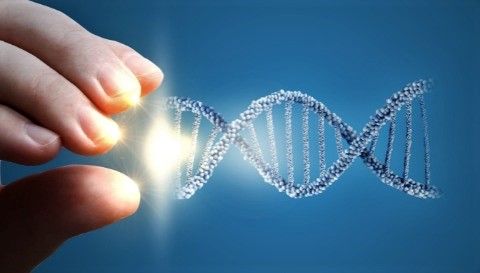We Won’t Use DNA to Identify the Messiah

In 1975, two New York inventors bonded liquid crystals with quartz stones and set them into rings. The “mood ring” became a fad; it was thought to change color based on the wearer’s mood. In reality, the rings were reacting to changes in body temperature.
There are, however, scientifically proven methods to read someone’s mood and uncover hidden secrets.
The FBI, for example, trains its agents to observe facial micro-expressions to determine emotions such as fear and happiness. Likewise, a lie detector polygraph test enhances human perception by measuring physiological indicators that can signal if someone is lying.
More recently, DNA tests can identify certain family relationships and even help convict criminals.
Hundreds of years ago, these scientific methods would have been considered magic. However, simply because we do not understand how something works does not mean it is not possible. As Albert Einstein said, “If you can’t explain it simply, you don’t understand it well enough.”
In this week’s Torah portion, Tetzaveh (Exodus 27:20-30:10), we learn about a garment worn by the High Priest, the Kohen Gadol, which could clarify difficult questions. The “breastplate of judgment” [משפט חשן–choshen mishpat], worn by the High Priest, was made of “gold, blue, purple, and crimson wool, and twisted fine linen” (Exodus 28:15).
Twelve precious stones, each engraved with the name of one of the twelve tribes of Israel, were set on the breastplate. In addition, a parchment known as the “Urim V’Tumim” [lights and sincere devotion], was inscribed with one of God’s sacred Names and placed within the fold of the breastplate.
Then, this breastplate provided the High Priest with the ability to prophetically answer questions and “determine judgment for the children of Israel” (Exodus 28:30).
Our sages explain that during the Second Temple, when the Divine Presence was less revealed, “the spirit of prophecy departed” (Yoma 9b), and the breastplate of judgment did not respond to questions.
Our sages did not say prophecy “ceased” because, although it “departed,” it will return in the messianic age, as God says, “I will pour out My Spirit upon all flesh, and your sons and daughters shall prophesy” (Joel 2:28). Additionally, the book of Ezra states that the prophetic power of the breastplate of judgment will also return in the future.
The book of Esther records the Purim miracle and the salvation from King Ahasuerus’ decree to annihilate the Jewish people. Before the miracle, King Cyrus of Persia had granted the Jews permission to return to Israel and rebuild Jerusalem and the Temple. Cyrus’ edict was so significant that he is referred to as God’s “anointed one” [1] (Isaiah 45:1).
Under the leadership of Ezra, between 40,000 and 50,000 Jews left Persia and returned to Israel. In addition to overseeing the rebuilding of the Temple, Ezra reestablished Jewish observances and recorded family lineages. Although many families were able to present their family tree, one stood out as an exception when they could not present their genealogical records. As a result, this family was excluded from the priesthood until their genealogy would be resolved in the future when “a priest will arise with the Urim V'Tumim” (Ezra 2:62-63).
This story also provides a powerful refutation to missionaries. They mistakenly claim that “all genealogical records were stored in the Temple” and were subsequently lost when the Romans destroyed the Second Temple. They incorrectly argue that the messiah arrived before the destruction of the Temple because, without genealogical records, no one can prove that he meets the messianic requirements of being from the tribe of Judah and a descendant of King David.[2]
However, there is no evidence that genealogical records were stored exclusively in the First or Second Temples. On the contrary, the events in Ezra’s time prove that many people possessed personal records that survived the destruction of the First Temple. Additionally, after witnessing the destruction of the First Temple, it is doubtful that they would risk keeping records only in the Second Temple. In fact, the Talmud [Yevamot 49a] documents that genealogical records were discovered in Jerusalem after the destruction of the Second Temple. Finally, even if the future messiah cannot provide family records, his lineage will be confirmed when the “Urim V'Tumim” returns.
Today, most Jews are descendants of the tribe of Judah, and some individuals have records that trace their lineage to King David. However, even if we do not possess genealogical records, by following the Torah, we are part of a remarkable spiritual heritage that traces back to the founders of monotheism, Abraham, Isaac, and Jacob. This heritage is our spiritual DNA.
Shabbat Shalom,
Rabbi Bentzion Kravitz
[1] The Hebrew word for anointed, [משיח–moshiach], describes a variety of subjects, including Jewish kings, prophets, priests, objects, and in this case, a non-Jewish king. Therefore, it is essential to check the context to determine the correct topic of discussion.
[2] As stated in Ezekiel 37:24-28, the messiah must also gather the Jewish people back to Israel, rebuild the Jewish Temple, and usher in universal world peace and the knowledge of God.
© 2023 Jews for Judaism • P.O. Box 351235, Los Angeles, CA 90035 • 310-556-3344
info@JewsforJudaism.org • www.jewsforjudaism.org/donate • www.SMARTalks.com
 We Won’t Use DNA to Identify the Messiah
We Won’t Use DNA to Identify the Messiah